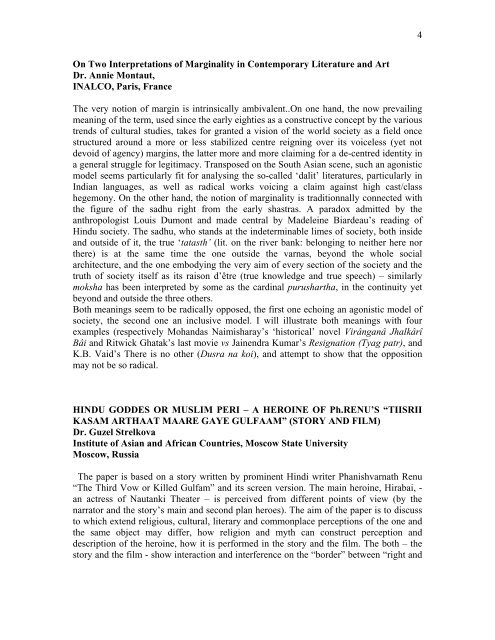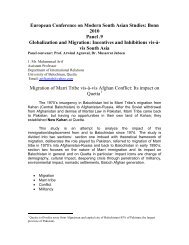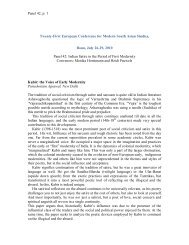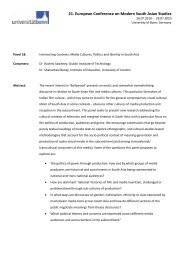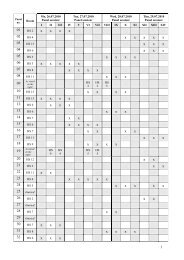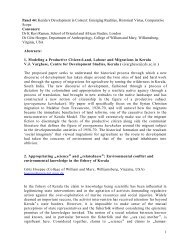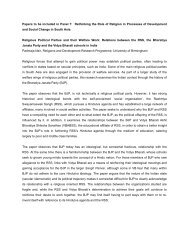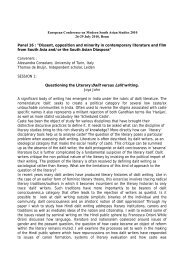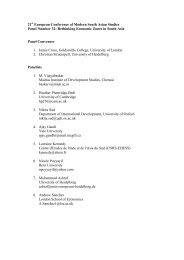Panel 13
Panel 13
Panel 13
Create successful ePaper yourself
Turn your PDF publications into a flip-book with our unique Google optimized e-Paper software.
On Two Interpretations of Marginality in Contemporary Literature and Art<br />
Dr. Annie Montaut,<br />
INALCO, Paris, France<br />
The very notion of margin is intrinsically ambivalent..On one hand, the now prevailing<br />
meaning of the term, used since the early eighties as a constructive concept by the various<br />
trends of cultural studies, takes for granted a vision of the world society as a field once<br />
structured around a more or less stabilized centre reigning over its voiceless (yet not<br />
devoid of agency) margins, the latter more and more claiming for a de-centred identity in<br />
a general struggle for legitimacy. Transposed on the South Asian scene, such an agonistic<br />
model seems particularly fit for analysing the so-called ‘dalit’ literatures, particularly in<br />
Indian languages, as well as radical works voicing a claim against high cast/class<br />
hegemony. On the other hand, the notion of marginality is traditionnally connected with<br />
the figure of the sadhu right from the early shastras. A paradox admitted by the<br />
anthropologist Louis Dumont and made central by Madeleine Biardeau’s reading of<br />
Hindu society. The sadhu, who stands at the indeterminable limes of society, both inside<br />
and outside of it, the true ‘tatasth’ (lit. on the river bank: belonging to neither here nor<br />
there) is at the same time the one outside the varnas, beyond the whole social<br />
architecture, and the one embodying the very aim of every section of the society and the<br />
truth of society itself as its raison d’être (true knowledge and true speech) – similarly<br />
moksha has been interpreted by some as the cardinal purushartha, in the continuity yet<br />
beyond and outside the three others.<br />
Both meanings seem to be radically opposed, the first one echoing an agonistic model of<br />
society, the second one an inclusive model. I will illustrate both meanings with four<br />
examples (respectively Mohandas Naimisharay’s ‘historical’ novel Virânganâ Jhalkârî<br />
Bâi and Ritwick Ghatak’s last movie vs Jainendra Kumar’s Resignation (Tyag patr), and<br />
K.B. Vaid’s There is no other (Dusra na koi), and attempt to show that the opposition<br />
may not be so radical.<br />
HINDU GODDES OR MUSLIM PERI – A HEROINE OF Ph.RENU’S “TIISRII<br />
KASAM ARTHAAT MAARE GAYE GULFAAM” (STORY AND FILM)<br />
Dr. Guzel Strelkova<br />
Institute of Asian and African Countries, Moscow State University<br />
Moscow, Russia<br />
The paper is based on a story written by prominent Hindi writer Phanishvarnath Renu<br />
“The Third Vow or Killed Gulfam” and its screen version. The main heroine, Hirabai, -<br />
an actress of Nautanki Theater – is perceived from different points of view (by the<br />
narrator and the story’s main and second plan heroes). The aim of the paper is to discuss<br />
to which extend religious, cultural, literary and commonplace perceptions of the one and<br />
the same object may differ, how religion and myth can construct perception and<br />
description of the heroine, how it is performed in the story and the film. The both – the<br />
story and the film - show interaction and interference on the “border” between “right and<br />
4


